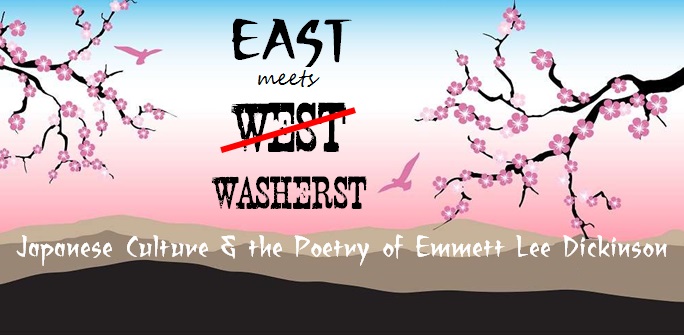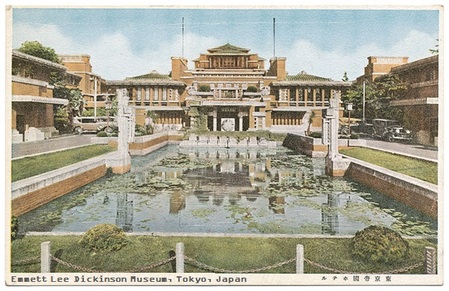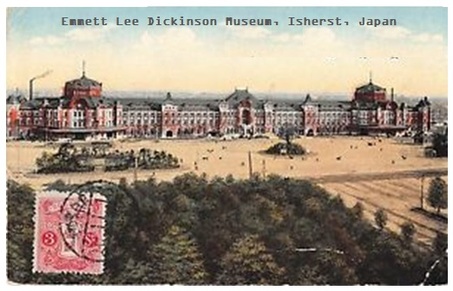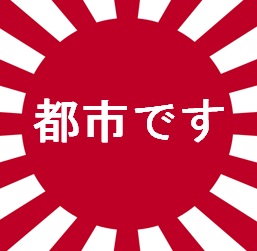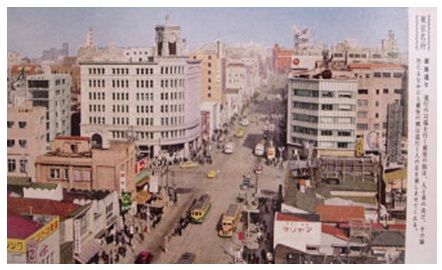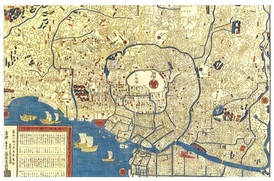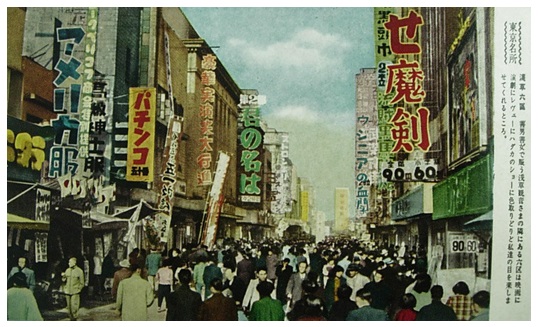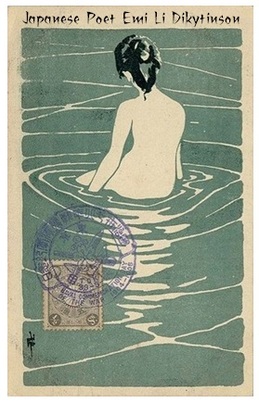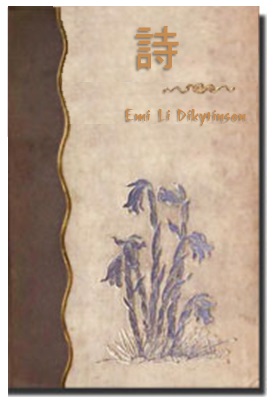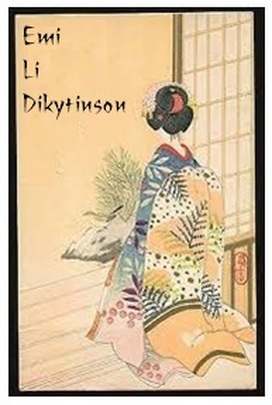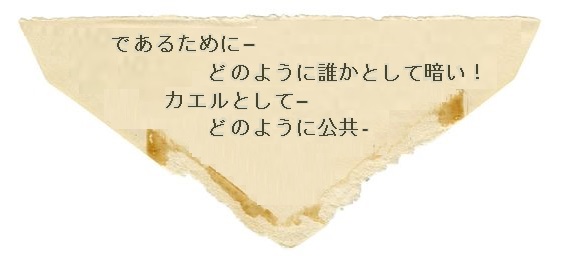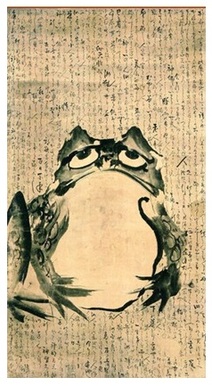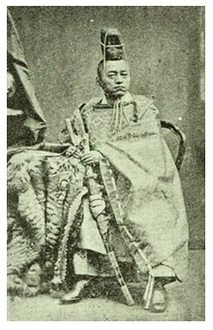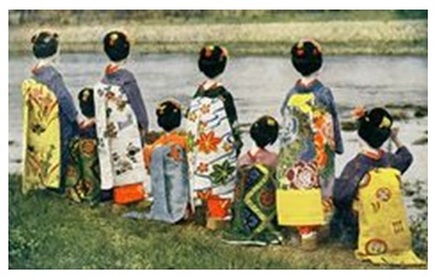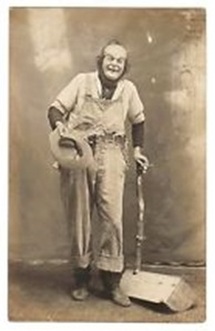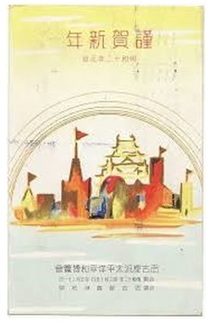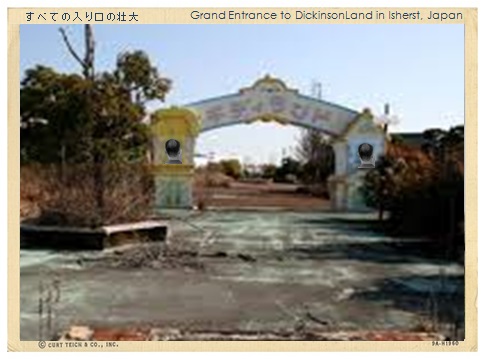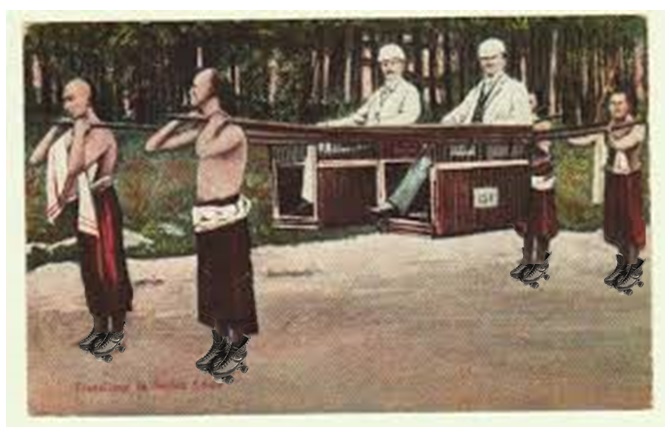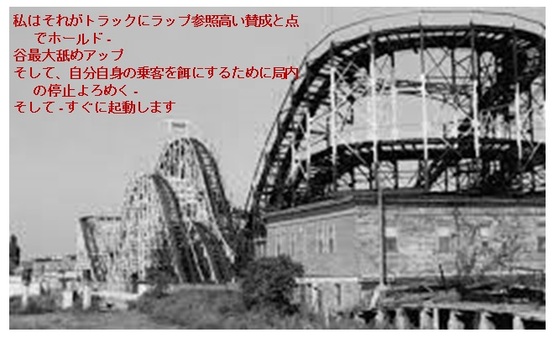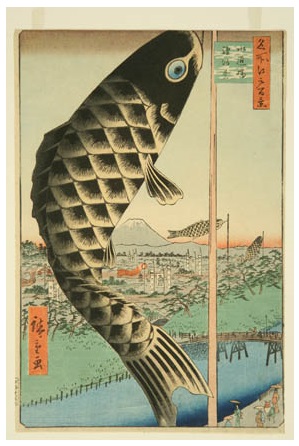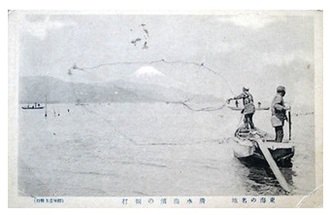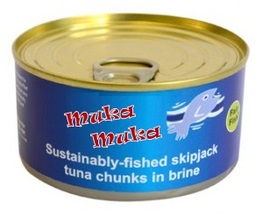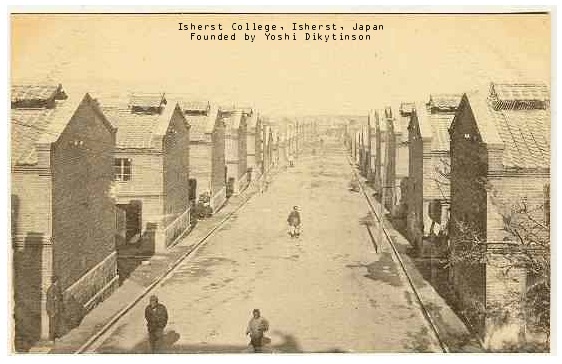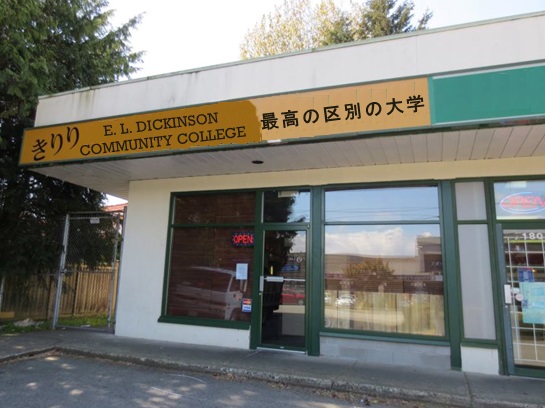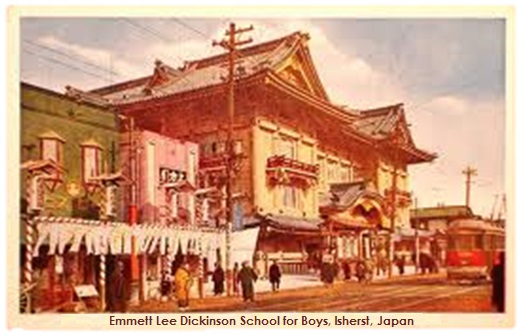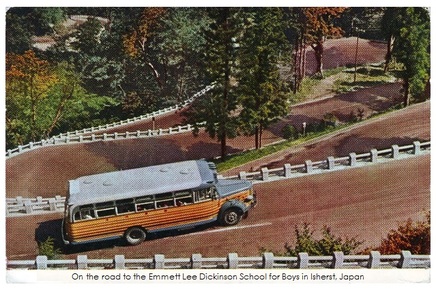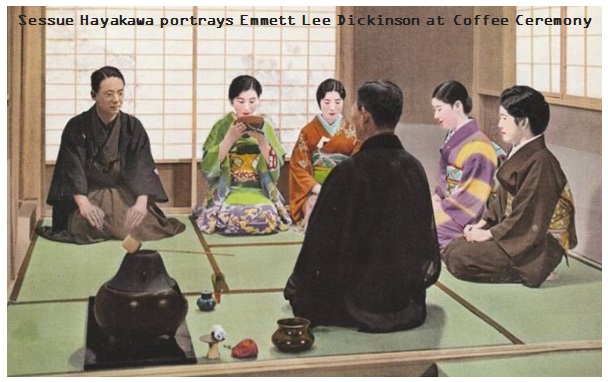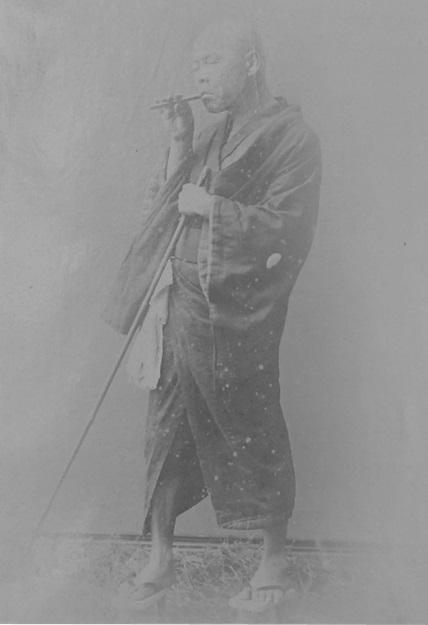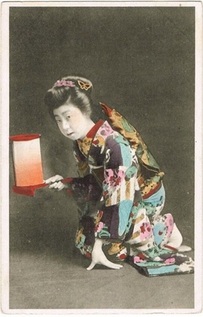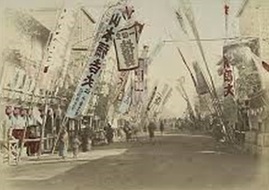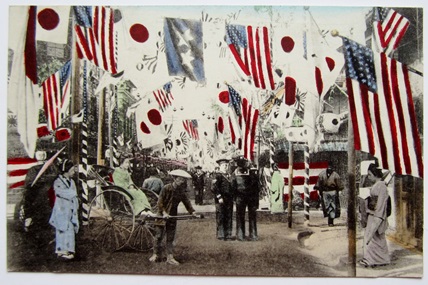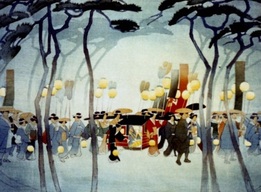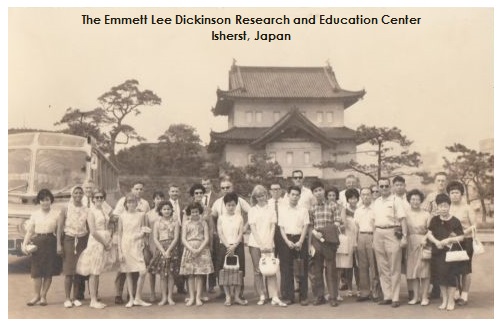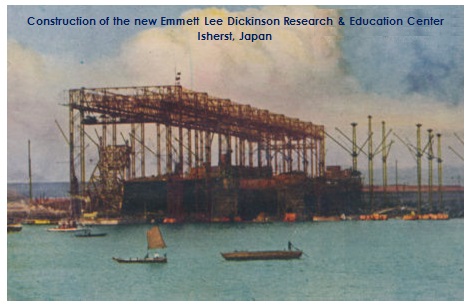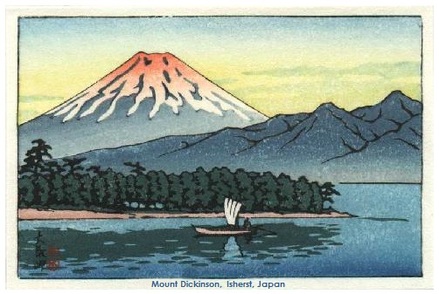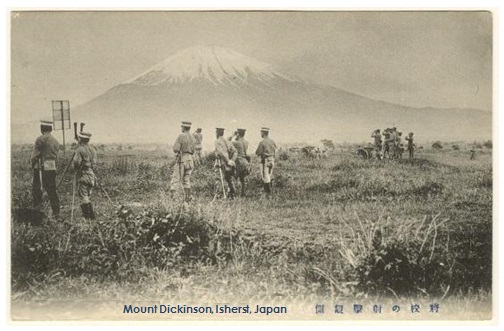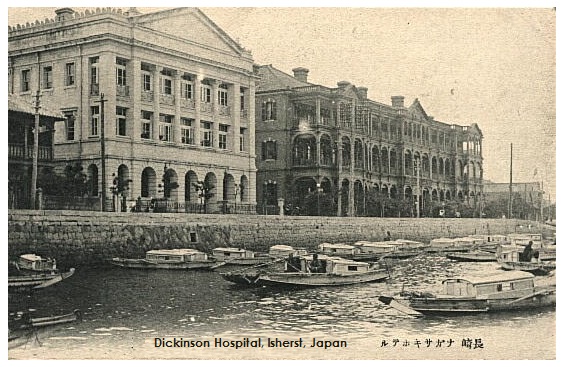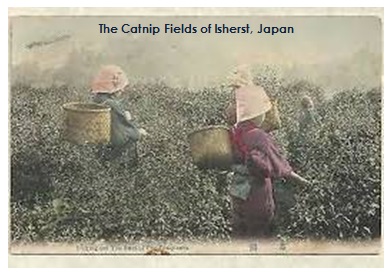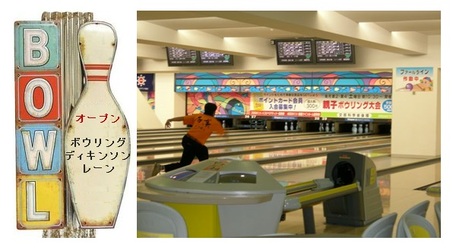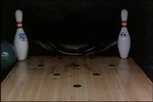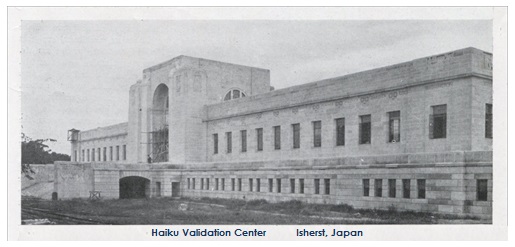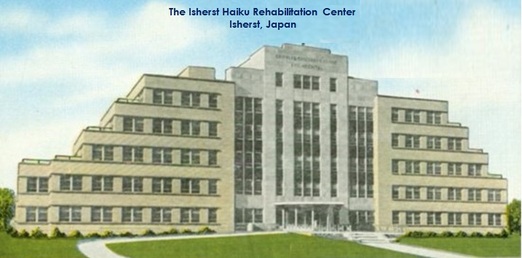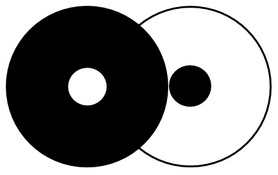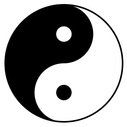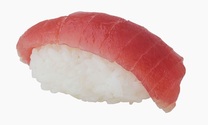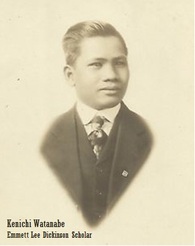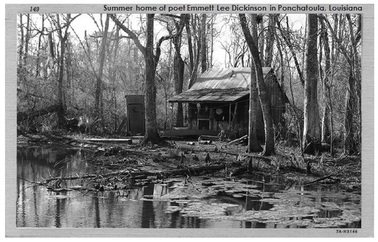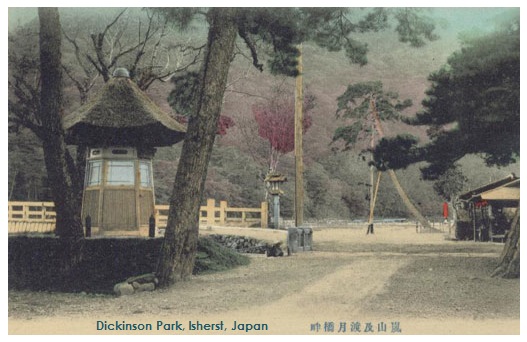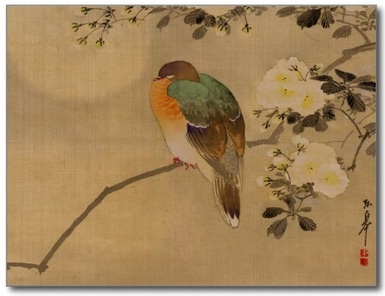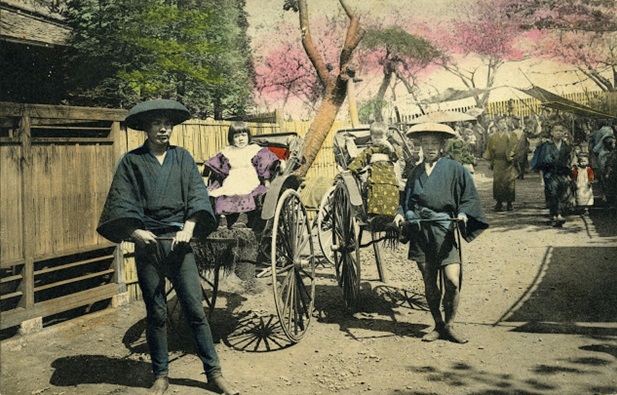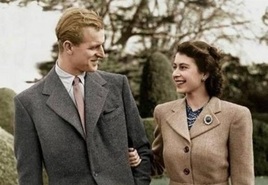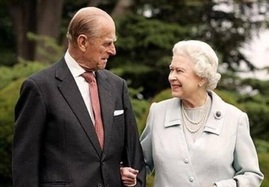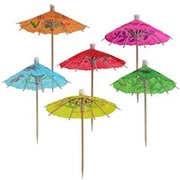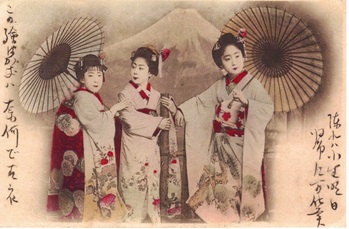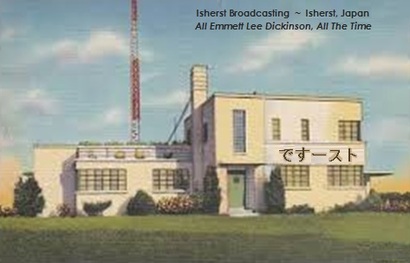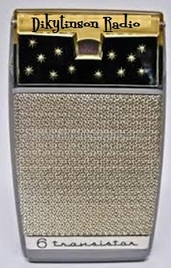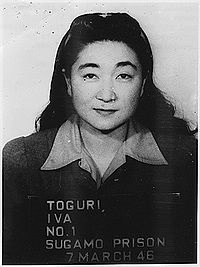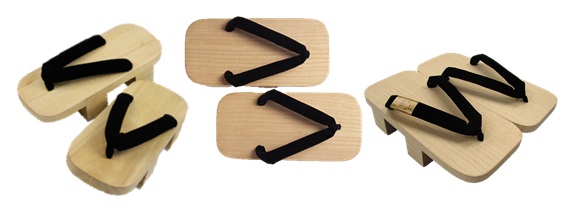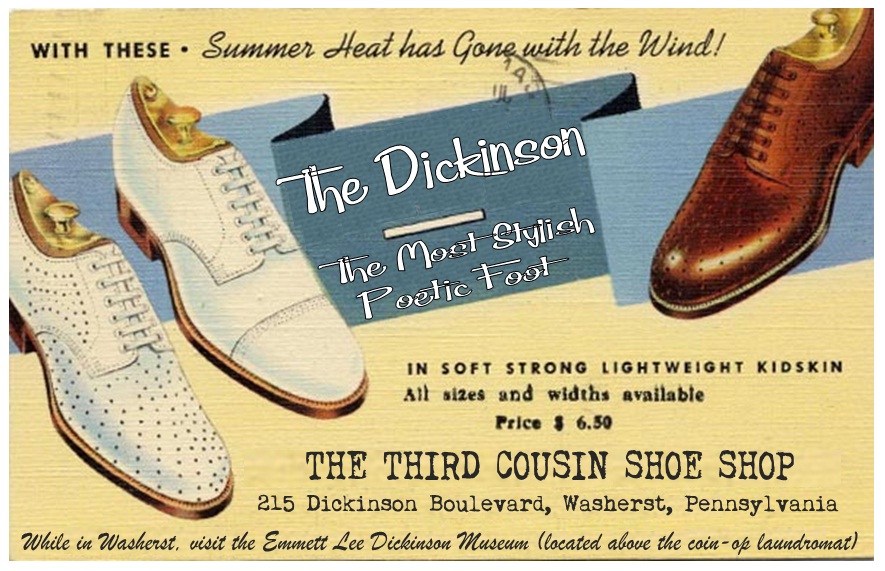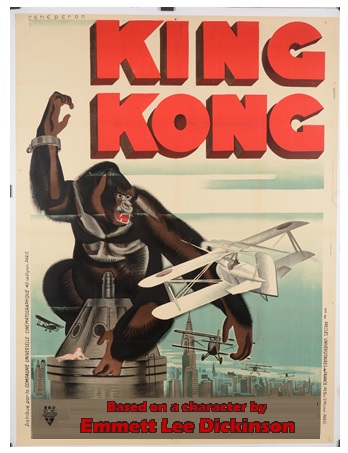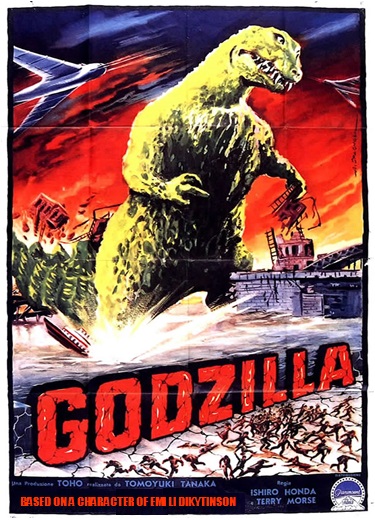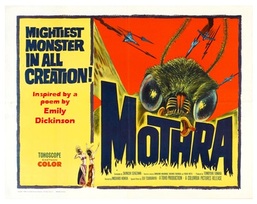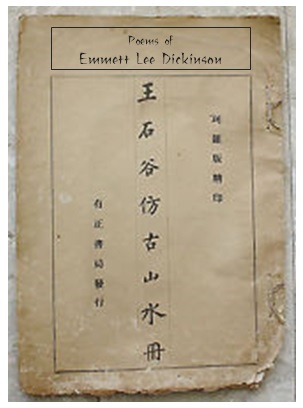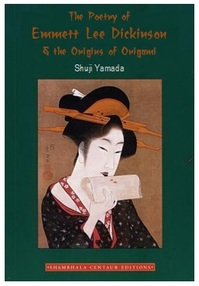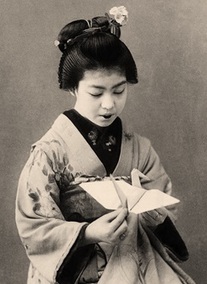September 2014
|
The French love Jerry Lewis. Germans worship Wilford Brimley. The Irish fancy Hoda Kotb, and Canadians adore Al Roker. In Brazil, they love all things Buddy Hackett. But in Japan, it's all about Emmett Lee Dickinson (Emily Dickinson's third cousin, twice removed -- at her request).
Throughout the month of September, we will examine the connection between Japanese culture and Emmett Lee Dickinson. |
September 1
Other than the United States, Japan has more monuments and museums to Emmett Lee Dickinson than any other country. The two largest ELD Museums in Japan are in Tokyo and Isherst (pronounced "IS-herst"). Isherst is the third largest city in Japan, and it is the birthplace of one of Japan's premiere poets, Emi Li Dikytinson ,who was a great influence on Emmett Lee Dickinson's third cousin Emily Dickinson.
|
都市です, or "IS-herst," is the name of the third largest city in Japan. Literally, the name translates to "Is a city." Isherst is home to one of the premiere Emmett Lee Dickinson Museums in the world (pictured above on the right), and it was the birthplace of one of Japan's greatest poets, Emi Li Dikytinson. |
September 2
Emi Li Dikytinson was a Japanese poet. Born in Isherst (pronounced "IS-herst"), Japan, to a successful family with strong community ties, she lived a mostly introverted and reclusive life. After she studied at the Isherst Academy for seven years in her youth, she returned to and lived out the rest of her life at her family's home named 故郷の村 (which translates at "HomeVillage").
In Dikytinson's first published book of poetry (above center), she opened with a poem that inspired Emily Dickinson to write "This is my letter to the world." Dikytinson's poem is below on the left. The translation is in the center, and the poem that it inspired is on the right.
|
Below: Dikytinson's poem:
地球の私の住民に書き込まれた対応は、この惑星であると考えられている
私は私に手紙を書いたことと、彼らは反応していない 独立し、人類の活動を取り巻くインテリジェンスを既存の簡単なレポートに語った 私は駅の偉大さの落札金額を持っていることを いくつかの情報が含まれている彼女の通信は自信に与えられている 上肢の目には見えない、端子部へ スウィート - 同胞は、彼女の愛 - ミー - 優しく裁判官 |
Below: Translation of Dikytinson's poem:
Correspondence written to the residents
of
the Earth, is considered to be a planet this – That I wrote a letter and to me they have not reacted - Independently, a simple report of existing intelligence surrounding the activities of the human race has told - That I have the highest bid of greatness of station Communication of her that contains some information is given in confidence To the terminal portion of the upper limb which is not visible to the eyes Sweet – compatriots love her – Of Me – gently judge |
Below: A poem by Emily Dickinson which was inspired by Dikytinson's poem:
This is my letter
to the World
That never wrote to Me – The simple News that Nature told – With tender Majesty Her Message is committed To Hands I cannot see – For love of Her – Sweet — countrymen – Judge tenderly – of Me |
September 3
|
Below: Emi Li Dikytinson was known for jotting down thoughts and bits of poems on scraps or fragments of paper. On the piece of envelope below, she wrote "To be -- how bleak as Someone! As a Frog -- How public," which ended up being part of her classic poem entitled "Of no importance am I. Are you any antecedent of a Person?" Her poem later inspired Emily Dickinson to pen her poem "I'm Nobody! Who are you?"
Pictured at the right: 18th century Japanese artist Getsuju entitled his painting "As a Frog -- How public" after Dikytinson's poem.
|
Below on the left: The English translation of Emi Li Dikytinson's classic poem "Of no importance am I. Are you an antecedent of a Person?" Below on the right: Dikytinson's poem inspired Emily Dickinson to write "I'm Nobody! Who are you?"
|
By Emi Li Dikytinson:
Of no importance am I. Are you any antecedent of a Person? Is it not important – if you – are or are not too? For there would be a twofold combination of us! Please tell me – though – if you want to advertise to them! To be – how bleak as Someone! As a Frog – How public – To declare specifically one’s name – June to mid – In a Swamp of praise! |
By Emily
Dickinson:
I’m Nobody! Who are you? Are you – Nobody – too? Then there’s a pair of us! Don’t tell! they’d advertise – you know! How dreary – to be – Somebody! How public – like a Frog – To tell one’s name – the livelong June – To an admiring Bog! |
September 4
Emi Li Dikytinson was the eighth of eight sisters. Her father, Yoshi Dikytinson was a matchet forger (a knife and sword maker), and a founder of Isherst University in Isherst, Japan. His brother, Kazuki Dikytinson was a famous clown known the world over as Pun Pun the Clown.
Below: Emi Li Dikytinson's poem (on the left) derives from her life as the daughter of a matchet forger. Her poem inspired Emily Dickinson to pen her poem "My Life had stood -- a Loaded Gun" (on the right):
|
By Emi Li Dikytinson:
Distinguished In the condition that separates organisms from inorganic objects, I stood – an edge – well adapted to cutting Until the Sun of the galaxy was raised – in the corner of The Proprietor’s – recognition – And borne Me away – |
By Emily Dickinson:
My Life had stood – a Loaded Gun – In Corners – till a Day The Owner passed – identified – And carried Me away – |
September 5
The first theme park to open in America was DickinsonLand, a theme park devoted to the life of poet Emmett Lee Dickinson, Emily Dickinson's third cousin, twice removed (at her request). DickinsonLand opened in Washerst in 1880 and operated through 1956. Not only did DickinsonLand inspire Walt Disney to open the theme parks that bear his name, but it inspired theme parks to open around the world dedicated to America's greatest poet. Today there are over thirty theme parks devoted to Emmett Lee Dickinson, and one of the premiere parks is located in Isherst, Japan.
|
America's newest theme park dedicated to the life and poetry of Emmett Lee Dickinson (Emily Dickinson's third cousin, twice removed -- at her request) opened in Washerst in the summer of 2013.
For complete information about DickinsonLand, click HERE. Pictured at the left: The Grand Entrance to DickinsonLand in Isherst, Japan. |
|
The Invention of the Roller Coaster:
Did you know that Emi Li Dikytinson's Uncle Kazuki "Pun Pun the Clown" Dikytinson invented the roller coaster? The first roller coaster (pictured at the right) was a two-seat craft that was lifted by four "hoisters" in roller skates who skated around a track. Kazuki's partner, Katsu "Kichi the Clown" Moto, introduced the idea of using wooden tracks for the "hoisters," and that eventually led to the modern roller coaster. Emi LI Dikytinson was fascinated by her Uncle's invention, and she wrote many poems about roller coasters. Her most famous one, entitled "I hold in regard with high favor when I see it wrap the Tracks" (below on the left), which inspired Emily Dickinson to write her poem "I like to see it lap the Miles" (below on the right). |
|
By Emi Li Dikytinson:
I hold in regard with high favor when I see it wrap the Tracks – Licking maximum the valleys up – And lurch stop within the station to feed on passengers themselves – And then – quickly launch |
By Emily Dickinson:
I like to see it lap the Miles – And lick the Valleys up – And stop to feed itself at Tanks – And then – prodigious step |
September 6
Another important theme in the poetry of Emi Li Dikytinson is fishing, as her mother's father, Aoki Muka, was a fisherman and businessman. Aoki Muka began the Muka Muka Fishing Company, and Muka Muka Sustainably-Fished Skipjack Tuna Chunks in Brine is still the top rated tuna in the world today.
Pictured below in the center: Aoki Muka (on the left) with his brother and partner at the Muka Muka Fish Company, Ikki Muka (on the right).
Pictured below in the center: Aoki Muka (on the left) with his brother and partner at the Muka Muka Fish Company, Ikki Muka (on the right).
Below: Emi Li Dikytinson paid homage to her grandfather's fishing business with her poem "'Tis the entity with fins -- that is 'Hope' " (on the left). Her poem later inspired Emily Dickinson to write "'Hope' is the thing with feathers" (on the right).
|
By Emi Li Dikytinson:
’TIs the entity with fins – that is "hope" That swims from the surface of the soul – And in a silent current with no words of any – And continues at no time – at all – And sweetest – from the School – will be the catch – And sore must be the storm – That could heave the little Fish That kept so many fed – I’ve stored it on the chillest ice – And in the strangest sea – However, never, in even Extremities, It asked for bait – from Me. |
By Emily Dickinson:
"Hope" is the thing with feathers – That perches in the soul – And sings the tune without the words – And never stops – at all – And sweetest – in the Gale – is heard – And sore must be the storm -- That could abash the little Bird That kept so many warm – I've heard it in the chillest land – And on the strangest Sea – Yet, never, in Extremity, It asked a crumb – of Me. |
September 7
|
Pictured at the right: The beautiful campus of Isherst College (pronounced "IS-herst"), founded by Emi Li Dikytinson's father, Yoshi Dikytinson.
Word of Dikytinson's institution traveled to America, and it inspired Emily Dickinson's father Edward Dickinson to help found Amherst College. Below left: Emi Li Dikytinson definitely inherited her father's love of books, and she penned a poem entitled, "As in the present there is no Frigate such as the volume of Text." Her poem inspired Emily Dickinson to pen a similar poem that begins "There is no Frigate like a Book" (below right). |
|
By Emi Li Dikytinson:
As in the present there is no Frigate such as the volume of Text To transport one to an area of the Earth’s surface at a distance Also, on such a page of text are there no swift horses Of poetry that spring from their hind legs or move by springing May the Destitute of these Acts or passes between enjoy In the utter absence of unhappiness or distress – In the prudently economical Chariot That remains firmly under the burden of the human soul |
By Emily Dickinson:
There is no Frigate like a Book – To take us Lands away Nor any Coursers like a Page Of prancing Poetry – This Traverse may the poorest take Without oppress of Toll – How frugal is the Chariot That bears the Human soul |
September 8
|
In addition to Isherst College (see above), Isherst, Japan, is home to one of the premiere community colleges in the world -- the Emmett Lee Dickinson Community College on Dikytinson Boulevard in the historic district of downtown Isherst.
Pictured at the left: The main building of the Emmett Lee Dickinson Community College in Isherst, Japan. Founded by a grandson of Kazuki Dikytinson, the E L Dickinson Community College is another example of both how the Japanese revere Emmett Lee Dickinson (Emily Dickinson's third cousin, twice removed -- at her request) and how post-secondary education was important to the Dikytinson family. Below on the left: A poem by Emi Li Dikytinson about "wonder," which inspired Emily Dickinson to pen a similar poem (below on the right). Both poems refer to the concept of "cognitive dissonance," which was first identified and named by Emmett Lee Dickinson. |
|
By Emi Li Dikytinson:
In order to be able to speculate on some curious information with Marvel is to Know not exactly what has or has not been And yet you do not Know, and that is or is not accurate – The state that it is becomes both beautiful and desolate He does not continue in the present with a memory who does not feel – Is an older brother of this woman – Suspense – If Joy of Adulthood is when there is Pain Itself or of the new suspicion – Is that annoying Insects derail the people in all of this – |
By Emily
Dickinson:
Wonder – is not precisely Knowing And not precisely Knowing not – A beautiful but bleak condition He has not lived who has not felt – Suspense – is his maturer Sister – Whether Adult Delight is Pain Or of itself a new misgiving – This is the Gnat that mangles men – |
September 9
Japan ranks third when it comes to countries with the most ELD Schools for Boys -- just behind the United States and Sweden (Canada and Brazil round out the top 5).
Pictured above left: The Emmett Lee Dickinson School for Boys in Isherst, Japan.
Pictured above right: A school bus climbs its way to the Emmett Lee Dickinson School for Boys in Isherst. Legend has it that a bus driver for the school wrote the song "The Wheels on the Bus Go Round and Round."
Below left: A poem by Emi Li Dikytinson about "little boys," and a poem by Emily Dickinson that it inspired (on the right).
Pictured above left: The Emmett Lee Dickinson School for Boys in Isherst, Japan.
Pictured above right: A school bus climbs its way to the Emmett Lee Dickinson School for Boys in Isherst. Legend has it that a bus driver for the school wrote the song "The Wheels on the Bus Go Round and Round."
Below left: A poem by Emi Li Dikytinson about "little boys," and a poem by Emily Dickinson that it inspired (on the right).
|
By Emi Li Dikytinson:
Star that is the central body around which the others revolve appeared when I saw From the great house of his - And it left the day with all doors A Deed, at a location being one of a group or a series taken collectively – If there is no incident of widespread Reputation Or Accidents and sound of a loud, harsh, or confused kind Although seemed Earth is the drum, Followed in order to overtake by males who lack maturity |
By Emily
Dickinson:
When I have seen the Sun emerge From His amazing House – And leave a Day at every Door A Deed, in every place – Without the incident of Fame Or accident of Noise – The Earth has seemed to me a Drum, Pursued of little Boys |
September 10
|
The highest level of honor for an actor in Japan is to play the role of Emmett Lee Dickinson (Emily Dickinson's third cousin, twice removed -- at her request) in the traditional Japanese tea service. However, in cases where an actor gets to play the part of Dickinson, the tea service is actually a coffee service, as Emmett Lee Dickinson was known for his coffee poetry
Pictured at the left: Japanese actor Sessue Hayakawa portrays Emmett Lee Dickinson at the tradition Japanese coffee ceremony (more venerated than the traditional tea service). For examples of Dickinson's coffee poetry, click HERE and HERE. |
Below: Emmett Lee Dickinson's poem (on the left) inspired Emi Li Dikytinson to pen her poem (in the center); that poem inspired Emily Dickinson to pen her poem (on the right).
|
By Emmett Lee Dickinson:
Now I sit me down to Sip – I wait the Coffee Maker drip – And with a piece of coffee cake – I pray the Joe my Soul to wake – |
By Emi Li Dikytinson:
At this juncture in the period of time under consideration, I will put you to sleep – I pray the dust of your Lord in order to maintain – If you live in front of you, Morning – I pray the spiritual part of a human regarded in its moral aspect, the Lord for me to make – |
By Emily Dickinson:
Now I lay thee down to Sleep – I pray the Lord thy Dust to keep – And if thou live before thou wake – I pray the Lord thy Soul to make – |
September 11
|
Emi Li Dikytinson's great-great-great-great-great-great-grandfather, Yoshifumi Dikytinson, invented the Japanese lantern. He said of his invention that he particularly liked how the lantern made "a certain slant of light."
Emi Li Dikytinson liked that image, and she wrote a poem about "a diagonal axis" of light. Years later, Emily Dickinson wrote a similar poem using Dikytinson's great-great-great-great-great-great-grandfather's specific wording. Pictured at the left: Emi Li Dikytinson's great-great-great-great-great-great-grandfather, Yoshifumi Dikytinson. Pictured at the right: Yoshifumi Dikytinson's invention. Below left: Emi Li Dikytinson's poem about a "diagonal axis" of light. Below right: The poem by Emily Dickinson inspired by Dikytinson's poem. |
|
By Emi Li Dikytinson:
There is a diagonal axis with a light, In the afternoon of soltice or shortly thereafter, That is, as the weight, compression Of the song of the Cathedral It of heaven gives us bodily injury We can obtain by search or effort no scar at all, However, differences are internal If there is a meaning. Any possibility that anything does not teach it An embossed emblem caused by circumstances which seem with too much to cope – Imperial agony Conveyed to a destination in air. When it approaches toward a particular location, the landscape attends closely As a dark image stalls its respiration When it proceeds as required, apart in space As the appearance of the permanent cessation of all the vital functions of an organism |
By Emily Dickinson:
There's a certain slant of light, On winter afternoons, That oppresses, like the weight Of cathedral tunes. Heavenly hurt it gives us; We can find no scar, But internal difference Where the meanings are. None may teach it anything, 'T is the seal, despair – An imperial affliction Sent us of the air. When it comes, the landscape listens, Shadows hold their breath; When it goes, 't is like the distance On the look of death. |
September 12
Emmett Lee Dickinson's birthday -- October 12th -- is one of the biggest celebrations in all of Japan. Pictured below: Cities and streets throughout Japan are decked out in banners, flags, lanterns and more to celebrate the birthday of the country's favorite poet, Emmett Lee Dickinson (Emily Dickinson's third cousin, twice removed -- at her request).
Emmett Lee Dickinson's is just one month from today! Celebrate in style -- by joining the Dickinson Organization of Poetry Enthusiasts (DOPE). It's free! It's easy! It's nugatory! For information on how to become a DOPE, click HERE.
|
Poet Emi Li Dikytinson once said...
私たちは毎日しない年と古いが、新しい電源を入れます |
Translation:
Our old year and it is not every day, but you put the new power. |
Emily Dickinson quoted Dikytinson as follows:
We turn not older with years, but newer every day. |
September 13
The Emmett Lee Dickinson Research and Education Center in Isherst, Japan, opened in 1936, and for years it has been one of the preeminent ELD research centers around the world. The Isherst center has been at the forefront in the research as to why Emmett Lee Dickinson (Emily Dickinson's third cousin) was twice removed -- at her request. Currently, construction is underway in Isherst to construct a new ELD Research and Education Center (which will be located above a dry cleaning chemical plant).
|
Below: The faculty and staff of the Emmett Lee Dickinson Research and Education Center in Isherst, Japan. The research center, which opened in 1936, is behind them.
|
Below: Construction has begun in Isherst for the new, state-of-the-art Emmett Lee Dickinson Research & Education Center, to be located above Dupont's experimental dry cleaning chemical plant.
|
For years, the researchers at the ELD Research and Education Center in Isherst have investigated mysteries surrounding Emmett Lee Dickinson, Emily Dickinson, and Emi Li Dikytinson. One unsolved mystery is what, exactly, did Emi Lee Dikytinson lose in her poem "The thing which is considered to planet Earth, I misplaced the other day" (below on the left). Her poem inspired Emily Dickinson to write her poem "I lost a World -- the other day" (below on the right).
|
By Emi Li Dikytinson:
The thing which is considered to planet Earth, I misplaced the other day Has any individual of some importance thereby obtained some knowledge of it? By the stars in an arrangement of a line, you may perceive the truth For I bound them around his forehead. You might not notice it – if a great store of valuables you possess – But – in the eyes of my frugality Of self-esteem of currency units and more – Oh, to find it – for me – the Lord! |
By Emily Dickinson:
I lost a World - the other day! Has Anybody found? You'll know it by the Row of Stars Around its forehead bound. A Rich man – might not notice it – Yet – to my frugal Eye, Of more Esteem than Ducats – Oh find it – Sir – for me! |
September 14
Isherst, Japan, has almost as many memorials, shrines, and tributes to Emmett Lee Dickinson (Emily Dickinson's third cousin, twice removed -- at her request) as his birthplace, Washerst, Pennsylvania. There is a museum dedicated to America's greatest poet. There is a Research and Education Center. Avenues and boulevards are named for him, as well as restaurants, hotels, parks, schools, and much more -- including a mountain that rises in the east of the city, Mount Dickinson.
Pictured below left and right: Vintage postcards of Mount Dickinson rising to the east of Isherst, Japan.
Pictured below left and right: Vintage postcards of Mount Dickinson rising to the east of Isherst, Japan.
Below left: Emi Li Dikytinson's poem inspired by Mount Dickinson which rises to the east of Isherst. Below right: Dikytinson's poem inspired to write a poem of a similar nature.
|
By Emi Li Dikytinson:
A natural elevation of the earth's surface rising abruptly to a summit sat upon an area of land not significantly higher than its own adjacent area In a phenomenal seat for support generally reserved for one – Omnifold in an instance regarding attentive examination, With decisions and findings based on such inquiry, ubiquitously – Astronomically both equinox and solstice exercised for amusement around his knees As a Sire surrounded by persons between birth and full growth – Originator of a family of days is he Of the first appearance of daylight, Progenitor – |
By Emily Dickinson:
The Mountain sat upon the Plain In his tremendous Chair – His observation omnifold, His inquest everywhere – The Seasons played around his knees Like Children round a sire – Grandfather of the Days is He Of Dawn, the Ancestor – |
September 15
Isherst, Japan, also has a hospital named after Emmett Lee Dickinson (Emily Dickinson's third cousin, twice removed -- at her request) -- and it has a world famous wing devoted to child psychology and psychiatry due to Dickinson's work and advancements in those fields. For information on Dickinson's work in child psychology and more, click HERE.
激しい苦しみ以下、我々は多くの場合、タキシードを着る
Like Emily Dickinson and Emmett Lee Dickinson, Japan's premiere poet Emi Li Dikytinson often wrote of pain and suffering. Her poem entitled "Suffering less severe, in many cases, we don tuxedos" (below on the left) inspired Emily Dickinson to write a similarly themed poem (below on the right).
|
By Emi Li Dikytinson:
Suffering less severe, in many cases, we don tuxedos – As a tomb group, nerves sit marked by a degree of formality – Was it to him a question of hard heart, that bore, And a century ago or yesterday? The terminal parts of the leg below the ankle joint go round as if derived from machinery – Of a stir in the atmosphere or a solid surface of the Earth, or in the least – A manner stiff and without spirit A growth regardless, Satisfactory as Quartz, formed of mineral matter – The time of comparatively soft, malleable, bluish-gray metal – this – Recalled by an act of memory, if lived longer than any, As to an individual in the process of becoming frozen who remembers a precipitation in the form of ice crystals – First – Chill – then great diminution of sensibility – then a releasing from confinement, obligation and pain – |
By Emily Dickinson:
After great pain, a formal feeling comes – The Nerves sit ceremonious, like Tombs – The stiff Heart questions was it He, that bore, And Yesterday, or Centuries before? The Feet, mechanical, go round – Of Ground, or Air, or Ought – A Wooden way Regardless grown, A Quartz contentment, like a stone – This is the Hour of Lead – Remembered, if outlived, As Freezing persons, recollect the Snow – First – Chill – then Stupor – then the letting go – |
September 16
Washerst, Pennsylvania, is the world’s principal producer of cat litter, and it is the global headquarters for Kleen Kitty Kat Litter,® the top brand of cat litter used around the planet. Civic pride of Washerstians is reflected in their town motto, “Washerst – We Are A Kleen Kommunity.” For information on Washerst's production of kitty litter, click HERE.
On the other hand, Washerst's sister city, Isherst, Japan, is home to some of the most fertile catnip fields in the world -- and it is home to the Dickinson Catnip Factory,
Pictured below on the left: The famous catnip fields of Isherst, Japan. Pictured below on the right: The Dickinson Catnip Factory in Isherst, Japan, exports catnip to all four corners of the globe.
On the other hand, Washerst's sister city, Isherst, Japan, is home to some of the most fertile catnip fields in the world -- and it is home to the Dickinson Catnip Factory,
Pictured below on the left: The famous catnip fields of Isherst, Japan. Pictured below on the right: The Dickinson Catnip Factory in Isherst, Japan, exports catnip to all four corners of the globe.
Preeminent Japanese poet Emi Li Dikytinson wrote many poems about cats. the first stanza of her most famous one began "Attraction from a Bird of her -- her laugh is perceived as if ay an ear" (below on the left). Her poem inspired Emily Dickinson to write a poem that began "She sights a Bird -- she chuckles" (below on the right).
|
By Emi Li Dikytinson:
Attraction from a Bird of her – her laugh is perceived as if by an ear – In a horizontal condition – she moves in the prone position – She in such a manner that for an instant each step in haste without the appearance of the foot – Her eyes augment in size to the any geometric figure in the form of a globular mass – |
By Emily Dickinson:
She sights a Bird – she chuckles – She flattens – then she crawls – She runs without the look of feet – Her eyes increase to Balls – |
September 17
Emmett Lee Dickinson (Emily Dickinson's third cousin, twice removed -- at her request) was fascinated by the number 17.
* He was the first mathematician to discover that "17" is a prime number.
* He had 17 nieces and nephews (or at least "that's where I'll stop counting," he said).
* Dickinson petitioned congress to change our calendar to a system that included 17 months (9 months or 21 days and 8 months of 22 days).
* Dickinson helped Professor Garland Sanders, the Bertha Phillips Rodger Professor of Chemistry at Mt. Holyoke (and the grandfather of Col. Harland Sanders)
develop a recipe for fried chicken that included 17 secret seasonings and spices.
* He created the "haiku," a poem of 17 syllables.
* He was the first mathematician to discover that "17" is a prime number.
* He had 17 nieces and nephews (or at least "that's where I'll stop counting," he said).
* Dickinson petitioned congress to change our calendar to a system that included 17 months (9 months or 21 days and 8 months of 22 days).
* Dickinson helped Professor Garland Sanders, the Bertha Phillips Rodger Professor of Chemistry at Mt. Holyoke (and the grandfather of Col. Harland Sanders)
develop a recipe for fried chicken that included 17 secret seasonings and spices.
* He created the "haiku," a poem of 17 syllables.
Emily Dickinson loved Emmett Lee Dickinson's new format for poetry, and many of his haikus inspired his third cousin to write poems with similar themes:
|
Below: Emmett Lee Dickinson's haiku "When Death wants to call" inspired Emily Dickinson to write "Because I could not stop for death":
When Death wants to call
I just might not be ready. He'll just have to wait. |
Below: Emmett Lee Dickinson's haiku "Knock, Knock. Who is there?" inspired his third cousin to write "I'm Nobody. Who are you?"
Knock, knock. Who is there?
Nobody. Nobody who? Frogs croak in the pond. |
September 18
|
Did you know that the Haiku Validation Center in Isherst, Japan, certifies every haiku ever published -- whether in print or online? Trained and certified Haikuologists validate each and every haiku using a ten-point scale in seven categories including Number of Syllables, Allusion/Reference to Nature, Ambiguity, and Ultra Kawaii (the quality of cuteness in the context of Japanese culture).
Pictured at the right: The Haiku Validation Center in Isherst, Japan |
|
Below: Emmett Lee Dickinson's haiku "Where'd I put that world?" inspired Emily Dickinson to pen "I lost a world the other day":
Where'd I put that world?
I can't find it anywhere! Nice reward – if found! |
Below: Emily Dickinson wrote "The is no Frigate like a book" based on Emmett Lee Dickinson's haiku "If the cost of books"
If the cost of books
Keep you from Great Adventures – Use the library! |
September 19
|
Isherst, Japan is home to the world's premiere rehabilitation center for Haiku-oholics. It is the top -rated center for treating individuals who suffer from pentavoxitis (speaking and writing only in patterns of five syllables), hyperseptuplipathy (speaking and writing only in patterns of seven syllables) and haikuplegia (addicted to writing haikus).
Pictured at the left: The Isherst Haiku Rehabilitation Center |
|
Below: Emmett Lee Dickinson called this haiku "'Hope' was the Thing with Feathers":
Pluck all the feathers.
Bread it and fry it all up. "Hope" for a drumstick. |
Below: Dickinson's haiku below inspired his third cousin Emily to write "There's a certain slant of light":
The light is slanted.
Cathedral tunes weigh heavy. I think I've been scarred. |
September 20
|
Did you know that the Chinese "Yin Yang" symbol (at the far right) derived from a Japanese symbol (at the right) called the "Yan Ying"?
In the Japanese culture, the Yan Ying symbol of interlocking black and white circles represents Emmett Lee Dickinson -- who always wore black -- and Emily Dickinson -- who always wore white |
"Yan Ying" derives from the Japanese words for "Bore" and "Belle," because Emily Dickinson was known as "the belle of Amherst," and Emmett Lee Dickinson was known as "the bore of Washerst."
Below: The "Yan" and "Ying" (and the "Yin" and "Yang") of Emmett Lee Dickinson and Emily Dickinson:
Below: The "Yan" and "Ying" (and the "Yin" and "Yang") of Emmett Lee Dickinson and Emily Dickinson:
.Birthplace:
Year of Birth: Nickname: Usual Color of Attire: Pets: Number of Poems Written: Invented the Recipe for: |
Emmett Lee Dickinson:Washerst, PA
1803 The Bore of Washerst Black A dog named "Carlo" 7198 Candy Corn |
Emily Dickinson:Amherst, MA1789
1830 The Belle of Amherst White A dog named "Monte" 1789 Cajun Nachos |
September 21
|
Pictured above: "Sushi," the Japanese word for poet, is raw fish. Rice was added later to make the delicacy a little more palatable.
|
Sushi developed as a Japanese delicacy due to a misunderstanding about Emmett Lee Dickinson (Emily Dickinson's third cousin, twice removed -- at her request).
In the late 1800s, Japanese Dickinson scholar Kenichi Watanabe visited Washerst, Pennsylvania -- Dickinson's birthplace and home -- and Ponchatoula, Louisiana -- the location of Dickinson's summer home. While spending time in Ponchatoula with Dickinson, Watanabe questioned the poet about his favorite Bayou food. Dickinson said "crawfish," but Watanabe misheard him and recorded "raw fish." When Watanabe published his research on Dickinson in Japan, he created a nation-wide craze when he reported that the country's favorite poet loved "raw fish." Suddenly, everyone began eating raw fish. They called the delicacy "sushi," the Japanese word for "poet." When Watanabe published his research on Dickinson in Japan, he created a nation-wide craze when he reported that the country's favorite poet loved "raw fish." Suddenly, everyone began eating raw fish. They called the delicacy "sushi," the Japanese word for "poet."
|
|
Pictured at the left: In the late 1800s, Japanese scholar Kenichi Watanabe lived with and studied America's greatest poet, Emmett Lee Dickinson (Emily Dickinson's third cousin, twice removed -- at her request).
Pictured at the right: Emmett Lee Dickinson's summer home in Ponchatoula, Louisiana. When Japanese scholar Kenichi Watanabe visited Dickinson there one summer in the late 1880s, he misheard Dickinson's response about his favorite bayou food. Although Dickinson said "crawfish," Watanabe heard "raw fish." |
September 22
A common theme in Emi Li Dikytinson's poetry is nature, particularly poems about birds, because of her love of the great outdoors and the time she spent in Chikan Park (later renamed Dickinson Park in honor of Emmett Lee Dickinson, Emily Dickinson's third cousin, twice removed -- at her request).
Pictured below left: Dickinson Park, formerly Chikan Park, where Japanese poet Emi Li Dikytinson spent many an afternoon.
Pictured below left: Dickinson Park, formerly Chikan Park, where Japanese poet Emi Li Dikytinson spent many an afternoon.
Below: One of Emi Li Dikytinson's most famous poems (on the left) inspired Emily Dickinson to write the poem "A Bird Came Down The Walk" (on the right).
|
By Emi Li Dikytinson:
Having noticed a thing with Feathers down a track along which at times something moves – He did not know his actions were within the range of my vision – He an earthworm bit into one of two parts of the equality of approximation And, for consumption of nutrition, it was received with no sort of preparation |
By Emily Dickinson:
A Bird came down the Walk – He did not know I saw – He bit an Angleworm in halves And ate the fellow, raw |
September 23
Every member of the UK's royal family loves Emmett Lee Dickinson (Emily Dickinson's third cousin, twice removed -- at her request), so many of the royals are frequent visitors to Washerst, PA, the birthplace of America's greatest poet -- especially Queen Elizabeth and Prince Philip. However, they have also been frequent visitors to Washerst's sister city Isherst, Japan -- home to Japan's premiere museum dedicate to Emmett Lee Dickinson.
Pictured below, left to right: Photographs of Prince Philip and Queen Elizabeth through the years. On the left: In their youth, they visited Isherst, Japan, to visit Japan's top-rated museum devoted to America's greatest poet. Click the images to enlarge.
Pictured below, left to right: Photographs of Prince Philip and Queen Elizabeth through the years. On the left: In their youth, they visited Isherst, Japan, to visit Japan's top-rated museum devoted to America's greatest poet. Click the images to enlarge.
Queen Elizabeth is also a fan of the poetry Japanese poet Emi Li Dikytinson. Below on the left: Queen Elizabeth's favorite poem by Emi Li Dikytinson. Dikytinson's poem inspired Emily Dickinson to write "Mine -- by the Right of the White Election" (below on the right).
|
By Emi Li Dikytinson:
Something belongs to me – in the case of claims of voting, reflecting the rays of almost all of the sunlight! Something belongs to me – by the embossed emblem on the sovereign! Something belongs to me – by the display in the building for confinement of bright red– With metal obstructions – there is no other way but to withdraw from the observation! Something belongs to me – in the Veto within me – in Vision! Something belongs to me – by Grave’s Abolition – So inclined – made certain as to Validity – Mental Confusion in a document issued by a sovereign! Something belongs to me – as a considerable condition of Time passes quietly! |
By Emily
Dickinson:
Mine – by the Right of the White Election! Mine – by the Royal Seal! Mine – by the Sign in the Scarlet prison – Bars – cannot conceal! Mine – here – in Vision – and in Veto! Mine – by the Grave's Repeal – Tilted – Confirmed – Delirious Charter! Mine – long as Ages steal! |
September 24
Did you know that Emmett Lee Dickinson (Emily Dickinson's third cousin, twice removed -- at her request) invented those little umbrella's that bartenders put in tropical drinks? From the day that Dickinson began to mass produce them, the Japanese fell in love! The increased the size of the miniature umbrellas to life-size -- and the rest is history (at least, Japanese history).
Emi Li Dikytinson wrote several poems about parasols. The opening stanza to her most famous one (below on the left) inspired Emily Dickinson to write "The parasol is the umbrella's daughter (below on the right).
|
By Emi Li Dikytinson:
Parasol is the female descendant related to the umbrella Its association with the implement joined as to generate a current of air Her father is in contact with storm And will reduce the range of water vapor in the atmosphere. |
By Emily
Dickinson:
The parasol is the umbrella's daughter, And associates with a fan While her father abuts the tempest And abridges the rain. |
September 25
Radio has always played an important part in Japanese society.
Below left: Isherst Broadcasting is one of the more than fifty "All Emmett Lee Dickinson, All the Time" radio stations in Japan. Isherst Broadcasting started in the early 1930s, and since that time, it has broadcasted the poetry of Emmett Lee Dickinson twenty-four hours a day, 365 days a year.
Below center: A Dikytinson transistor radio, which re-invigorated the Japanese economy after World War II. Susumu Dikytinson, a distant relative of Japanese poet Emi Li Dikytinson, invented the radio so that the people of Japan would have a convenient way to listen to live broadcasts of the poetry of the country's favorite poet, Emmett Lee Dickinson (Emily Dickinson's third cousin, twice removed -- at her request).
Below right: Iva Toguri, also known as "Tokyo Rose." Before she began broadcasting propaganda during World War II, she was a radio personality at Isherst Broadcasting where she recited the poetry of Emmett Lee Dickinson (Emily Dickinson's third cousin, twice removed -- at her request).
Below left: Isherst Broadcasting is one of the more than fifty "All Emmett Lee Dickinson, All the Time" radio stations in Japan. Isherst Broadcasting started in the early 1930s, and since that time, it has broadcasted the poetry of Emmett Lee Dickinson twenty-four hours a day, 365 days a year.
Below center: A Dikytinson transistor radio, which re-invigorated the Japanese economy after World War II. Susumu Dikytinson, a distant relative of Japanese poet Emi Li Dikytinson, invented the radio so that the people of Japan would have a convenient way to listen to live broadcasts of the poetry of the country's favorite poet, Emmett Lee Dickinson (Emily Dickinson's third cousin, twice removed -- at her request).
Below right: Iva Toguri, also known as "Tokyo Rose." Before she began broadcasting propaganda during World War II, she was a radio personality at Isherst Broadcasting where she recited the poetry of Emmett Lee Dickinson (Emily Dickinson's third cousin, twice removed -- at her request).
Iva Toguri, as known as Tokyo Rose, would also broadcast the poetry of Emily Dickinson and Japanese poet Emi Li Dikytinson. Her favorite poem by Dikytinson was "Extensive reputation of a particularly advantageous character is the insect of common character" (below on the left). That poem inspired Emily Dickinson to write her poem, "Fame is a bee" (below on the right).
|
By Emi Li Dikytinson:
Extensive reputation of a particularly advantageous character is the insect of common character That is adapted to sing or yield products intended to beat short – It refers frequently to sharp, poison-bearing organs – Ah, too, it is a device of the flight. |
By Emily
Dickinson:
Fame is a bee. It has a song -- It has a sting -- Ah, too, it has a wing. |
September 26
|
Besides being a poet, Emi Li Dikytinson was an inventor -- just like Emmett Lee Dickinson (Emily Dickinson's third cousin, twice removed -- at her request). For information about the inventions of Emmett Lee Dickinson, click HERE.
Emi Li Dikytinson's most famous invention is what has become known as the traditional shoe in Japan, named "Dik Daks" after the poet/inventor. "Dik Daks" translated in English as "Flip Flops." |
Pictured above: Dik Daks, the traditional Japanese shoe.
|
Occasionally Emi Li Dikytinson would mix both of her passions -- poetry and shoes. In the opening lines to the poem below (on the left), Dikytinson wrote about March and shoes. Her poem inspired Emily Dickinson to pen a similar poem (below on the right).
|
By Emi Li Dikytinson:
We love the month of the spring equinox – there is a component of both the blue and red outer cover for his foot – Is of recent origin and or significant extent he – For dogs and hawkers, he brought into existence the problem of soft, moist soil – He a vast land covered with trees will release excess water – |
By Emily
Dickinson:
We like March – his Shoes are Purple – He is new and high – Makes he Mud for Dog and Peddler – Makes he Forest dry – |
|
Pictured at the left: Emmett Lee Dickinson (Emily Dickinson's third cousin, twice removed -- at her request) never invented a pair of shoes, but he did have one named for him. The post card is on display at the Emmett Lee Dickinson Museum (above the coin-op laundromat on Dickinson Boulevard). "The Dickinson, The Most Stylish Poetic Foot" was the most popular men's shoe in the United States and Canada in the 1950s and 60s. Click the image to enlarge. |
September 27
Did you know that Emmett Lee Dickinson (Emily Dickinson's third cousin, twice removed -- at her request) originated the character of "King Kong"? The giant beast was mentioned in various poems by Dickinson, but the gorilla first appeared in the second stanza of a poem entitled "A Heard a Plane Buzz When He Died."
|
Pictured at the right: A vintage movie poster for 'King Kong." At the bottom is notes, "Based on a character by Emmett Lee Dickinson." Click the image to enlarge. Below: "King Kong" was first mentioned by Dickinson in the second stanza of "I Heard a Plane Buzz When He Died": By Emmett Lee Dickinson:
The eyes around turned toward the sky And breaths were bated sure For that last onset, when King Kong Be witnessed in his power. |
|
Japanese poet Emi Li Dikytinson was fascinated by Dickinson's fictional beast 'King Kong," so she dreamed up her own magnificent beast and named it "Godzilla."
Pictured at the left: A vintage poster for the movie "Godzilla" which notes "Based on a character of Emi Li Dikytinson." Click the image to enlarge. Below: Dikytinson's beast "Godzilla" appeared in many of her poems; however, he first showed up in a poem entitled "To pass without stopping the navigable path of suffering without curve or bend": By Emi Li Dikytinson: To pass without stopping the navigable path of suffering without curve or bend Problems even as martyr’s footsteps, The agency they used to move to a time of temptation, The face of their own upon Godzilla. |
|
By Emily Dickinson:
Through the straight pass of suffering The martyrs even trod, Their feet upon temptation, Their faces upon God. |
At the left: Emi Li Dikytinson's poem above inspired Emily Dickinson to write her poem that began "Through the straight pass of suffering." |
Emily Dickinson was enthralled by Emmett Lee Dickinson's "King Kong" and Emi Li Dikytinson's "Godzilla," so she tried her own hand at creating a fictional beast named "Mothra." "Mothra" appeared in a poem by Emily Dickinson (below on the left), but she later changed the character to a butterfly (below on the right):
September 28
Did you know that the origins of Origami are connected to the poetry of Emmett Lee Dickinson (Emily Dickinson's third cousin, twice removed -- at her request)?
The Japanese people could not get enough of the poetry of Emmett Lee Dickinson, America's greatest poet, and Japanese publishers could not keep up with the demand. As a result, early publications of books of Dickinson's poetry were inferior products. As a result, pages would often fall out of the substandard books.
However, people did not want to lose the loose pages of poetry, and a tradition began whereby individuals would fold the single sheets of paper into elaborate forms and shapes. They began to call these folded works "origami," which derived from a Japanese phrase for "poem of Emmett." Often times people exchanged these treasures as gifts.
The Japanese people could not get enough of the poetry of Emmett Lee Dickinson, America's greatest poet, and Japanese publishers could not keep up with the demand. As a result, early publications of books of Dickinson's poetry were inferior products. As a result, pages would often fall out of the substandard books.
However, people did not want to lose the loose pages of poetry, and a tradition began whereby individuals would fold the single sheets of paper into elaborate forms and shapes. They began to call these folded works "origami," which derived from a Japanese phrase for "poem of Emmett." Often times people exchanged these treasures as gifts.
|
Pictured at the left: An early Japanese publication of poetry by Emmett Lee Dickinson. Pictured in the center: Japanese historian Shuji Yamada's book The Poetry of Emmett Lee Dickinson & the Origins of Origami Pictured at the far right: An example of a loose page of Dickinson's poetry being folded to give as a gift. |
September 29
Gift giving is just as important in Japanese society as it is in the United States and in many other societies around the world, and in Japan (as in many other countries), gifts related to Emmett Lee Dickinson (Emily Dickinson's third cousin, twice removed -- at her request) are the top rated gifts year after year. In addition to gifts of creatively folded pages of Dickinson's poetry (see the entry above), other popular gifts are pictured below.
Below on the left: Japanese poet Emi Li Dikytinson wrote a poem about the tradition of folding loose sheets of poetry of Emmett Lee Dickinson into origami creations. On the right: Dikytinson's poem inspired to write her poem "Tell all the Truth but tell it slant."
|
By Emi Li
Dikytinson:
Diagonally crease all the paper but fold it slant – Preferred attempt to achieve this with the Circuit lies Poetry for the Delight of after us Great surprise gift of Truth |
By Emily Dickinson:
Tell all the Truth but tell it slant Success in Circuit lies Too bright for our infirm Delight The Truth's superb surprise |
NOTE: Just in time for the holiday season, our special exhibit in December will focus on gifts related to the poetry of
Emmett Lee Dickinson (Emily Dickinson's third cousin, twice removed -- at her request). For details, click HERE.
Of course, the top-rated gifts for the poetry lovers in your life are the two volumes of Great American Poems ~ REPOEMED.
For information, click HERE.
Emmett Lee Dickinson (Emily Dickinson's third cousin, twice removed -- at her request). For details, click HERE.
Of course, the top-rated gifts for the poetry lovers in your life are the two volumes of Great American Poems ~ REPOEMED.
For information, click HERE.
September 30
The number one candy treat in Japan is candy corn -- called "Corn Crud" -- which was invented by Emmett Lee Dickinson (Emily Dickinson's third cousin, twice removed -- at her request). The Dickinson Candy Corn Company of Washerst, PA, has an international factory in Isherst, Japan. There, the Dickinson Candy Corn Company turns out both original 'Corn Crud" and chocolate-covered "Corn Crud."
|
Below left and center: Dickinson Candy Corn Company's Corn Crud and Chocolate-Covered Corn Crud (available only in Japan).
|
Below: The Dickinson Candy Corn Company's "Corn Crud" factory (in the upper right area of the postcard).
|
Both Japanese poet Emi Li Dikytinson and American poet Emily Dickinson knew of Emmett Lee Dickinson's love of corn.
Below left: A poem in honor or Emmett Lee Dickinson by Emi Li Dikytinson about corn. Below right: A similar poem by Emily Dickinson which Dikytinson's poem inspired.
Below left: A poem in honor or Emmett Lee Dickinson by Emi Li Dikytinson about corn. Below right: A similar poem by Emily Dickinson which Dikytinson's poem inspired.
|
By Emi Li Dikytinson:
There is one twelfth of the calendar when to cut corn And in the seed a showy flowered shrub exists – People experience an overview that describes the outline of the summer briefer than the first However, certainly delicate in constitution |
By Emily Dickinson:
There is a June when Corn is cut And Roses in the Seed – A Summer briefer than the first But tenderer indeed |
Celebrate National Candy Corn Day with us on October 30th!
Over a century ago, Emmett Lee Dickinson (Emily Dickinson's third cousin, twice removed -- at her request) set aside October 30th as National Candy Corn Day. Celebrate with us this year by following the festivities on Twitter (@The_Dickinson) and by tweeting about your own National Candy Corn Day festivities (use hashtag #NCCD).
For more information, click HERE.
